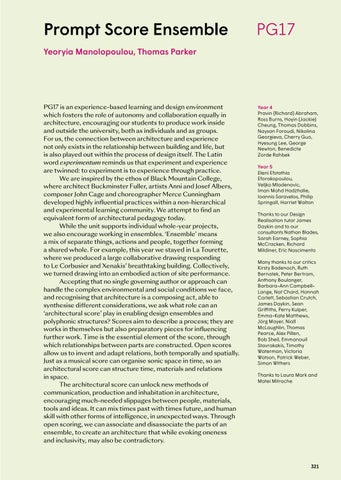Prompt Score Ensemble
PG17
Yeoryia Manolopoulou, Thomas Parker
PG17 is an experience-based learning and design environment which fosters the role of autonomy and collaboration equally in architecture, encouraging our students to produce work inside and outside the university, both as individuals and as groups. For us, the connection between architecture and experience not only exists in the relationship between building and life, but is also played out within the process of design itself. The Latin word experimentum reminds us that experiment and experience are twinned: to experiment is to experience through practice. We are inspired by the ethos of Black Mountain College, where architect Buckminster Fuller, artists Anni and Josef Albers, composer John Cage and choreographer Merce Cunningham developed highly influential practices within a non-hierarchical and experimental learning community. We attempt to find an equivalent form of architectural pedagogy today. While the unit supports individual whole-year projects, we also encourage working in ensembles. ‘Ensemble’ means a mix of separate things, actions and people, together forming a shared whole. For example, this year we stayed in La Tourette, where we produced a large collaborative drawing responding to Le Corbusier and Xenakis’ breathtaking building. Collectively, we turned drawing into an embodied action of site performance. Accepting that no single governing author or approach can handle the complex environmental and social conditions we face, and recognising that architecture is a composing act, able to synthesise different considerations, we ask what role can an ‘architectural score’ play in enabling design ensembles and polyphonic structures? Scores aim to describe a process; they are works in themselves but also preparatory pieces for influencing further work. Time is the essential element of the score, through which relationships between parts are constructed. Open scores allow us to invent and adapt relations, both temporally and spatially. Just as a musical score can organise sonic space in time, so an architectural score can structure time, materials and relations in space. The architectural score can unlock new methods of communication, production and inhabitation in architecture, encouraging much-needed slippages between people, materials, tools and ideas. It can mix times past with times future, and human skill with other forms of intelligence, in unexpected ways. Through open scoring, we can associate and disassociate the parts of an ensemble, to create an architecture that while evoking oneness and inclusivity, may also be contradictory.
Year 4 Pravin (Richard) Abraham, Ross Burns, Hoyin (Jackie) Cheung, Thomas Dobbins, Naysan Foroudi, Nikolina Georgieva, Cherry Guo, Hyesung Lee, George Newton, Benedicte Zorde Rahbek Year 5 Eleni Efstathia Eforakopoulou, Veljko Mladenovic, Iman Mohd Hadzhalie, Ioannis Saravelos, Philip Springall, Harriet Walton Thanks to our Design Realisation tutor James Daykin and to our consultants Nathan Blades, Sarah Earney, Sophia McCracken, Richard Mildiner, Eric Nascimento Many thanks to our critics Kirsty Badenoch, Ruth Bernatek, Peter Bertram, Anthony Boulanger, Barbara-Ann CampbellLange, Nat Chard, Hannah Corlett, Sebastian Crutch, James Daykin, Sean Griffiths, Perry Kulper, Emma-Kate Matthews, Jörg Mayer, Niall McLaughlin, Thomas Pearce, Alex Pillen, Bob Sheil, Emmanouil Stavrakakis, Timothy Waterman, Victoria Watson, Patrick Weber, Simon Withers Thanks to Laura Mark and Matei Mitrache
321
